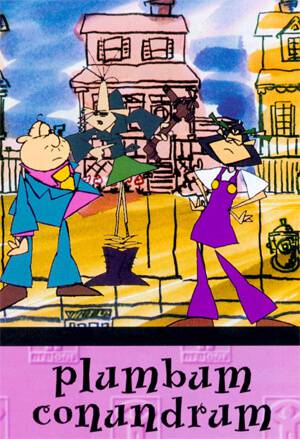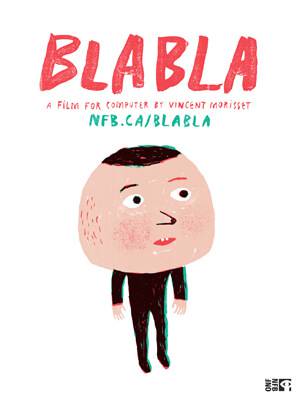Producing Animation: Michael Fukushima
Toward the end of 2013, following a long stint as an animation producer, Sheridan graduate Michael Fukushima took on the role of Executive Producer for the National Film Board of Canada‘s English-speaking animation studio. Since his role as producer began he has been involved in a large number of the NFB’s most noteworthy animated short films, including the recent stereoscopic delight The End of Pinky (Dir. Claire Blanchet), Sainte Barbe, Land of the Heads (Dir. Claude Barras/Cédric Louis) and the Oscar-nominated Dimanche (Dir. Patrick Doyon), as well as spearheading the Film Board’s long-running Hothouse apprenticeship, through which non-established Canadian animation filmmakers are given the opportunity to direct, animate and collaborate within the NFB each year. During a recent visit to the NFB offices we were delighted to be able to chat to Michael Fukushima about his relationship with the NFB and what the future has to offer.
Can you talk a bit about your background as an animation filmmaker and how that led to becoming a producer?
I studied animation at Sheridan College just outside of Toronto, it was a very traditional, classical 2D hand-drawn animation programme. I graduated and freelanced for a couple of years in and around Toronto before I made a proposal to the NFB. The executive producer at the time, Doug McDonald, had expressed an interest in me based on my student film, so every time I had a small idea I’d send him a two-pager and one year all the pieces just kind of fell into place. It was in 1989 and I sent a small proposal about my father who had been interned by the Canadian government during the Second World War because he was Japanese-Canadian. The Canadian government had only just recently made an apology and a settlement to the Japanese-Canadian community, so there was money to create media to inform Canadians about the episode. Doug managed to get some of that money and put it together with my proposal so I made my first NFB short in 1990 called Minoru, which was my father’s name. I think it was the first animated documentary at the NFB and one of the first ever; Paul Fierlinger had made a couple of animated docs prior to that but there hadn’t been that many, not like it is now. So that was quite successful, then I made another film for the NFB (Plumbum Conundrum, 1996), a commissioned film for a government agency. I was about to start on a third when a producer vacancy came up, which fit in with what I had been actively doing outside of film, trying to increase access to institutions; As a producer I had the chance to open up the doors a little bit and invite more filmmakers to come in. Two years after that my executive producer David Verrall and I co-created the Hothouse programme, and that really was our dream project. We’ve had more than fifty young filmmakers from across Canada come in over the past ten years, filmmakers who might never have had a chance to work with the NFB in any way before, so it’s really met my goals for becoming a producer – to open up access, give more filmmakers the opportunity to democratise the place in the process, and that’s going to continue to be one of my ambitions as an executive producer. So that’s kind of been my trajectory.
As a producer people ask me “Well, don’t you miss filmmaking?” I kind of missed it for a little while, but I quickly discovered that the films I was producing, the films I was selecting from the piles that were on my desk were films that, somewhere in the back of my mind I was thinking “Yeah, I’d love to make that one!” And so I was able to vicariously participate in the creation of those films.
Quite recently your role here at the NFB has progressed somewhat…
Yes, I recently started as the English animation studio Executive Producer after sixteen years, I think, as a producer.
What led to this development?
In much the same way that I’d become a producer after being a filmmaker for a dozen years, I just came to a point in my life and my career where there were other things that I wanted to do, where I wanted to have a larger impact in the community. As the executive producer I can help really set the ambition and vision of the studio for the next decade.

“Plumbum Conundrum” (1996), Michael Fukushima’s second directed short before embarking on his career as a producer
Are you able to talk a little bit about what that vision entails?
I’m not picturing radical change in the studio but I will be trying to implement some outlook change with the staff and the filmmakers who come to us. The Film Board has, over the past fifteen years, seen it’s budget reduced substantially; Every couple of years there’s another reduction which does cause some distress amongst both creators and staff, but my attitude and what I hope to instil in folks is we still have a very privileged position here at the NFB. Even though our budgets have been cut, this studio has more money to produce ‘auteur’ short animation films than probably any other studio or individual, every year – the only exception would maybe be Pixar. So we have a great position here and we need to embrace that as a positive.
‘Auteur’ filmmaking is a term that can have multiple meanings, when it’s coupled with the position of privilege you’ve just outlined do you mean ‘auteur’ in the sense of the attitude of the filmmakers and the creative freedoms they have?
Well, here we refer to ‘auteur’ as films that are primarily creatively-driven by a director-filmmaker. They have to work within an NFB context, so they have to work with a producer, editor, sound designer, composer, technical directors, all that. But the core, creative vision is theirs and we do our best to respect that. They’re signature films, they’re passion-driven films and by-and-large are produced and created solely by the filmmaker. We might put a small team of one or two animators around them from time to time, as needed, but 80-90% of the animation is generated by the filmmaker.
A lot of the known filmmakers with a lot of credibility attached to their name started their careers working with the NFB with their first professional film, could you discuss some of the ways that relationships with filmmakers begin at the NFB?
Central to that is the producer-filmmaker relationship, and the majority of the time we’re introduced to filmmakers at animation and film festivals, either directly when someone introduces us or by seeing their films. So producers here try to go to a lot of festivals and see a lot of films, and films that move us, films that impress us, films that feel like they could have come from here, we seek out those filmmakers and we engage them. If they’re Canadian that’s ideal as our mandate is to work with Canadian creators, but we also work with international filmmakers and co-productions. So we’ll approach filmmakers we’re interested in and ask them if they’ve ever thought of proposing a film to the NFB and more often than not, they have. On occasion filmmakers will say “No thank you, I’m not interested in working with a government agency, I’m not interested in working with a producer, I want to do my own thing”, but the majority of the time filmmakers will at least be interested. Then it’s up to the producer and the filmmaker to try to conjure up a project that fits.
Is there a system in place for interested filmmakers to approach the NFB first?
Absolutely, if filmmakers go to nfb.ca there’s a link to the institutional website, where they’ll find a couple of pages on the process and addresses for working with the NFB. Then just send a proposal – not a full bible proposal but three or four pages of text, a couple of images, a covering letter that provides context – to one of the producers and we’ll review it, the door’s open. We can’t finance an international film, so for international filmmakers it has to be a co-production, but if all those things are in place, if the project seems interesting to us, if it fits our mandate and we have the budget for it we’ll definitely entertain it.
One of the other things the NFB is highly commended for is its contributions to interactive media and app culture, with websites like Bla Bla, the McLaren app and the new StopMo Studio iPad app amongst others. When was that decision made to expand into those sorts of areas?
Truthfully we were a little bit behind the wave on that. I think web culture really took hold in the general public shortly after the millennium, and the Film Board decided take it very seriously around 2005/2006. Our primary motivator at the time was that we had this vast collection of animation and documentary films from, at this point, seventy-five years of film production. With the closing of public libraries and community centres that had our films on 16mm and VHS we were running out of ways for the Canadian public to have easy access to those films, so the film commissioner Tom Perlmutter looked to find a different distribution method for them. So our first efforts were on the web, to create a streaming website for as many of our films as possible – I think six or seven thousand of our films can be streamed for free on the web. Then the next logical step was “Okay, now people have these iPhones and smartphones, is there a way for us to deliver our content that way?” So we developed iPhone and iPad apps which were absolutely huge successes because people really did want to see a different kind of content on their phones. Then it was about five years ago that Tom gave a mandate to production that we needed to think about producing content expressly for web or for other digital platforms, not repurposing linear films onto the web but finding a way to actually use these platforms and these technologies as the foundations for the art that we create. That was a tough row to hoe, because film and interactive can be quite different from each other. I remember talking to filmmakers about user interaction, and they were horrified at the idea of a user even being able to stop a film or to comment on it.
But the NFB created two digital production studios, the French program and the English program, which have been quite bold in exploring interactive documentaries – The Last Hunt is a new tablet-based photo-essay, the Highrise project is a massive multimedia/multiplatform exploration of the history of the highrise. The French program has done a number of really interesting interactive installation projects like A Journal of Insomnia, they installed a project downtown called Megaphone which gave passers-by an opportunity to play in an interactive project. So in the past four or five years those two digital studios have really tried to push the form of what interactive media is. Then of course, as you say, the McLaren app has been huge, people love to play with that, and the new StopMo Studio is very close to being a professional animation studio – somebody could make a pretty polished film with this iPad app, it’s just stunning what’s possible now! So I’ve been very excited by what the film board has been doing digitally, I haven’t played in that arena as much as I would like, but it is a place that I think the two animation studios are going to do more with.
There are quite a lot of exciting projects in development, from established and new filmmakers, are there any films in particular that you’re really looking forward to see pan out?
Well, I’m also a parent so I should say I love them all equally! I’m really excited by Cordell Barker‘s new film, he’s exploring stop-motion puppetry which is something he has never done in his career, as well as working with an animation team on some of the animation, which is also something he’s never done with his own films. So it’s been a real challenge for him but the work he’s been producing so far has been spectacular. While her earlier films purported to be autobiographical by having to do with her family, but may or may not have been, Torrill Kove‘s new film Me & My Moulton is in fact autobiographical, it’s just charming as all get-out. So I’m really looking forward to those two. Sheldon Cohen, who is famous in Canada for having made The Sweater which is a Canadian classic, is working on a very personal film about having suffered a heart-attack and come through the other end, and it’s going to be a beautiful and moving film. So that’s three, I think we have four or five more that are slated to be released throughout 2014 and early 2015, which I’m sure you’ll hear about.
For more information on the work and films of the NFB you can visit nfb.ca




